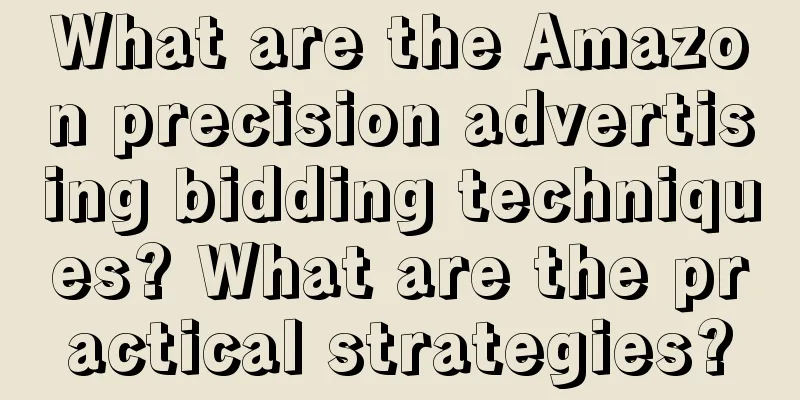What are the Amazon precision advertising bidding techniques? What are the practical strategies?

|
According to what we know, there are two types of bidding strategies for Amazon advertising campaigns: dynamic bidding and fixed bidding. Regardless of which method is used, merchants need to understand it. The following content will share some bidding tips with you. What are the Amazon precision advertising bidding techniques? 1. Ignoring Optimized Bidding If sellers want to gain benefits from bidding, they must optimize their bids. Many sellers ignore optimizing their bids and keep all ad bids the same without changing the bids. 2. Setting bids by guesswork When setting advertising bids, some sellers make bids based on their feelings, thinking that their sixth sense is very accurate. However, advertising bidding is not metaphysics and needs to be supported by data. 3. Bidding recklessly Bidding recklessly can cause your ads to cost too much. Just like guessing, bidding recklessly can hurt your ads’ performance. Don’t make drastic changes to your bids without evidence, unless you have sufficient data. 4. Excessive pursuit of low ACOS When new sellers discuss the advertising goals they want to achieve, low ACOS is one of the goals. Although ACOS of 1% looks good, you must have a lot of advertising budget left, so sellers should not be stingy with their bids. What are the practical strategies for Amazon advertising bidding? 1. Bid based on historical records Data can help sellers succeed. All sellers have to do is find the perfect CPC (cost per click) by calculating the revenue per click. Calculate the total x amount earned by the keyword and then divide it by the total number of clicks on the keyword to calculate the revenue per click. Calculate the revenue per click for the past 30 days, 60 days, and 90 days, understand the seasonal factors that affect the revenue per click, and the long-term effectiveness of keywords. After calculating the revenue per click, divide it by the target ACOS. The result is CPC, which is your bid. Here’s a simple trick: divide your target ACOS by your current ACOS, then multiply that ratio by your current CPC to get a CPC that meets your metrics. 2. Set expected conversion rates If there is no relevant advertising data for a product, the seller cannot calculate the bid based on historical records. However, the seller can set an expected conversion rate. 1) Expected conversion rate 2) Price of X 3) Target AcOS The expected conversion rate is how many clicks are needed to convert X. Amazon's average conversion rate is around 10%, so sellers can use 10% as your expected conversion rate. Price X is the product price, and Target ACOS is the seller’s ideal advertising cost. Amazon advertising is very important for sellers, and it is one of the important ways to increase exposure and sales. Therefore, Amazon merchants must pay attention to bidding skills in this regard. After mastering these skills, how can they help increase sales? Recommended reading: Should Amazon's automatic advertising keywords be denied? How to deny them? Will Amazon's suspension of advertising affect the weight? How to restore the effect? What indicators should be considered for Amazon advertising input-output? Detailed introduction |
<<: What is the difference between Amazon advertising click-through rate and conversion rate?
Recommend
What is the way out for ordinary people to start their own business?
This article starts from the entrepreneurial choic...
Are all corporate CEOs becoming internet celebrities? It makes people cry and feel sad
This article mainly discusses the phenomenon of co...
How does Shopee give partial refunds to customers? How to prevent refunds?
Shopee merchants must have encountered buyers'...
How do eBay buyers cancel orders? Steps
Ebay is an international e-commerce platform that ...
Is it feasible for digital people to sell goods?
Digital people bringing goods is a new retail mode...
How can a new Shopee store break zero? What are the methods?
After registering and opening a store on the Shope...
How much does it cost to buy a Shopee online store? Is it expensive?
There are many businesses that want to open a stor...
How long does it take for customers to receive products after Amazon FBA shipment?
Most people will choose the official FBA delivery ...
A brief history of Chinese milk tea conquering Europe
From tea leaves to milk tea, Chinese flavors have ...
Breaking out of the Red Ocean | Good content drives new brand growth
This article uses ten sentences and ten case studi...
Xiaohongshu’s benefits are not lost to outsiders
This year's Double Eleven battle is different ...
One live broadcast attracted millions of viewers, and the number of followers increased by over 100,000 in a single month. Is Xiaohongshu's content live streaming the next trend?
Xiaohongshu content live streaming is becoming a n...
Amazon India launches Sale Event Planner tool to help merchants plan events
Amazon India recently announced the launch of a ne...
Everything is a matter of growth. Based on the real situations of many companies, we have extracted several principles.
Describe the problems you encounter in detail. Not...
Ten thousand words long article: How B-side Internet products can acquire customers through multiple channels
It is much more difficult to acquire customers on ...









